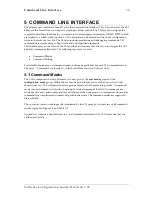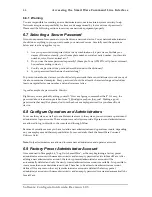
Command Line Interface
35
nodename#
In the administrator exec mode and in the different configuration modes
nodename(mode)#
Where:
•
nodename
is the currently configured name of the node (SmartNode), the IP address or the
hardware type of the device that is being configured, and
•
mode
is a string indicating the current configuration mode, if applicable.
Example
: the prompt in
configuration mode
, assuming the nodename
SN
is
SN(config)#
Table 5-1 shows the CLI commands used to enter each mode and the system prompt that is
displayed when you are working within each mode.
5.1.2 Navigating the CLI
Initial Mode
When you initiate a session you may login with either operator or administrator privileges.
Whichever login you use, on starting the CLI is always set to the operator exec (nonprivileged exec)
mode by default. This mode allows you to examine the state of the system using a subset of the
available CLI commands.
System Changes
In order to make any changes to the system, the administrator exec (privileged exec) mode must be
entered. The
enable
user interface command is used for this purpose. Once in administrator exec
mode, all of the system commands are available to you. The enable command is only accessible if
you are logged in as an administrator.
Configuration
To make configuration changes the configuration mode must be entered by using the
configure
command in the administrator exec mode. From here the other configuration modes are accessible as
diagrammed in the overview in Figure 5-1.
Changing Modes
Within any configuration mode, the
exit
command brings the user up one level in the mode
hierarchy. For example, when in
pvc
configuration mode, typing
exit
will take you to
framerelay
configuration mode.
The
exit
command terminates a CLI session when typed from the operator exec mode.
A session can also be terminated using the
logout
command within any mode.
Software Configuration Guide, Revision 1.03
Summary of Contents for SmartWare R2.00
Page 2: ......
















































